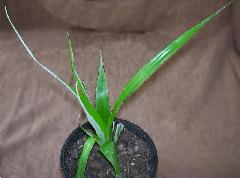
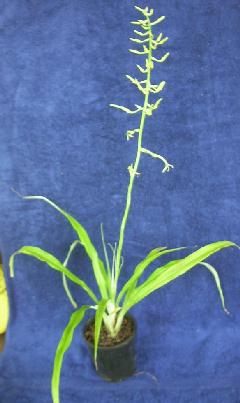
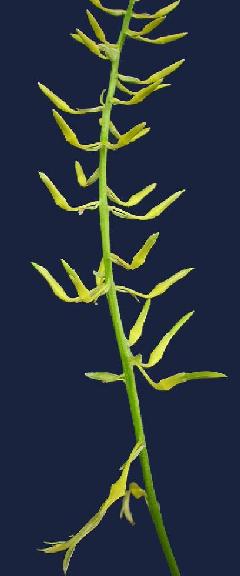
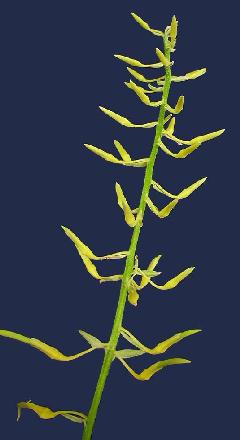
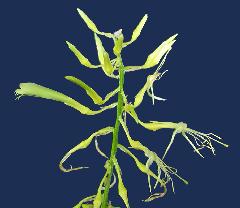
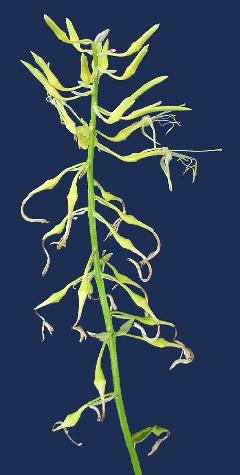
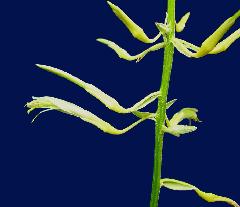

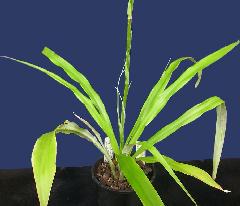
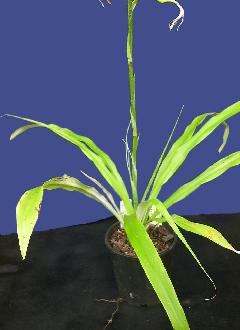

Key to the Varieties of Pitcairnia flammea
Leaf blades spiny at base - var spinulosa
Leaf blades entire:
1. Leaf-blades covered beneath with spreading scales, mostly 20-36 mm wide.
- 2. Axis of the inflorescence glabrous, usually turning black on drying. - var flammea.
- 2. Axis of the inflorescence lepidote, usually remaining pale. - var roezlii.
1. Leaf-blades glabrous or, if lepidote, always less than 20 mm wide; inflorescence remaining
pale
- 3. Axis of the inflorescence glabrous; leaf-blades glabrous.
- - 4. Inflorescence lax, few-flowered. - var corcovadensis. NOW species in own right
- - 4. Inflorescence dense, at least toward apex, many-flowered.
- - - 5. Petals red - var glabrior.
- - - 5. Petals yellowish white. - var pallida.
- 3. Axis of the inflorescence lepidote.
- - - 6. Floral bracts equaling or exceeding the lower pedicels. - var floccosa.
- - - 6. Floral bracts shorter than the lower pedicels; pedicels to 35 mm long. var macropoda.
Pitcairnia flammea var flammea
Leaf-blades mostly 20-36 mm wide, covered beneath with spreading scales.
Inflorescence with axis glabrous and usually turning black on drying.
DISTRIBUTION. Saxicolous, especially by streams, 200-1000 m alt, east central Brazil.
Pitcairnia flammea var roezlii
Leaf-blades mostly 20-36 mm wide, covered beneath with spreading scales.
Inflorescence with axis lepidote, usually remaining pale.
DISTRIBUTION. Terrestrial and saxicolous, borders of forest, 500-800 m alt, Rio de Janeiro and Guanabara, Brazil.
Pitcairnia flammea var glabrior
Leaves glabrous.
Inflorescence dense, at least toward apex, many-flowered, remaining pale; axis glabrous. Petals red.
DISTRIBUTION. Saxicolous, 600-1600 m alt, east central Brazil.
Pitcairnia flammea var pallida
Leaves glabrous.
Inflorescence dense, at least toward apex, many-flowered, remaining pale; axis glabrous. Petals yellowish white.
DISTRIBUTION. Saxicolous, especially by streams, Espirito Santo and Rio de Janeiro, Brazil. BRAZIL.
Pitcairnia flammea var floccosa
Leaf-blades less than 20 mm wide, lepidote.
Inflorescence remaining pale; axis lepidote.
Floral bracts equaling or exceeding the lower pedicels.
DISTRIBUTION. Saxicolous, 700-1900 m alt, eastern Brazil.
Pitcairnia flammea var floccosa
Leaf-blades less than 20 mm wide, lepidote.
Inflorescence remaining pale; axis lepidote.
Floral bracts equaling or exceeding the lower pedicels.
DISTRIBUTION. Saxicolous, 700-1900 m alt, eastern Brazil.
Pitcairnia flammea Lindl. var macropoda
Leaves 8 mm wide, bearing linear reddish scales beneath when young.
Inflorescence lax, 18 cm long, floccose.
Floral bracts linear-triangular, to 18 mm long;
pedicels ascending, slender, to 35 mm long.
Sepals linear-lanceolate, ecarinate, acute, 22 mm long.
TYPE. Magalhaes s n (holotype, HB; photo, US), locally frequent on ledges, Alto da Usina, Mun. Tombos, ca 20°54'S, 42°02'W, Minas Gerais, Brazil, 8 Apr 1950.
DISTRIBUTION. Known from the type collection only.
Pitcairnia flammea Lindley var spinulosa
Habitat: Brasil, Estado de Minas Gerais, Serra do Cipo.
"P. flammea is a very variable species, six varieties having been described already. In revising the specimens of Pitcairnia from the herbarium of the. Museu Botanico Municipal of Curitiba, Parana, I found this plant on which I did not find enough characters to establish a new species however the clearly spinose margins of the basal portion of the leaves permit to separate it at least as a new variety. With more and better specimens available perhaps other characters can be found which will permit to separate this taxon as a distinct species."